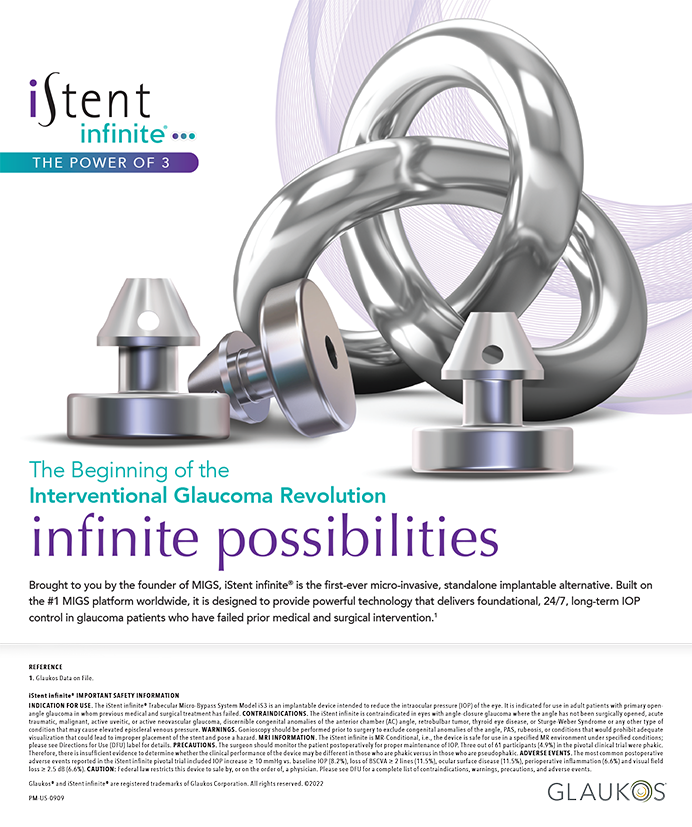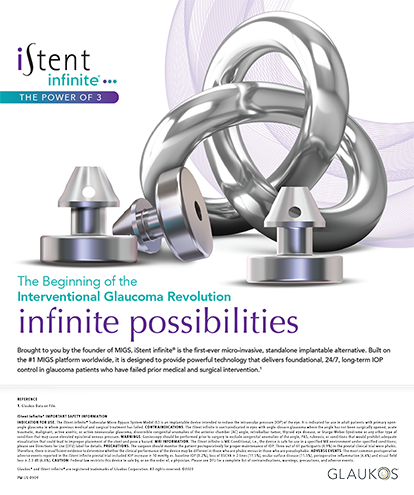As the reports of prostaglandin-associated periorbitopathy (PAP) accumulate, clinicians and their patients face some new questions regarding the management of glaucoma.
EARLY CASES
In 2008, my colleagues and I described a series of five patients with significant periorbital changes ipsilateral to the eye treated with bimatoprost. On inspection of the adnexal tissues, there was an absence of dermatochalasis, a deep crease in the upper eyelid suggestive of levator dehiscence, ptosis of the upper lid, decreased prominence of the inferior orbital fat pads, and approximately 2 mm of enophthalmos relative to the fellow untreated eye. The power of these cases is that the unilateral nature of the glaucoma allowed each patient to serve as a control for age-related changes to the eyelids. Furthermore, in two cases, no other glaucoma medicines were used, and there was clear documentation that these adnexal changes were not preexisting. Discontinuing bimatoprost in these two cases resulted in a significant reversal of the aforementioned findings, ruling out the unlikely possibility that a diagnosis of glaucoma contributed to the adnexal changes. Finally, in one case, the adnexal findings confounded the workup of concomitant neuro-ophthalmic disease, prompting the performance of magnetic resonance imaging. In this case, neuroimaging ruled out primary orbital pathology as the source of the periorbitopathy.
Collectively, this case set unequivocally proved that bimatoprost caused the adnexal changes described. Interestingly, only two of the five patients were cognizant of the changes. After several unsuccessful attempts to publish these findings, they were ultimately accepted by Ophthalmic Plastic and Reconstructive Surgery.1
PREVALENCE AND MEDICATION
As of this writing, 15 cases of PAP have been reported with bimatoprost, and three cases have been reported with travoprost.2-7 Exactly how pervasive is this side effect? If one accepts that the patient on bilateral bimatoprost treatment shown in Figure 1 also has PAP and not merely age-related periocular changes, then I suspect this side effect is relatively common.
Do patients taking latanoprost experience this side effect? Yes, Figure 2 shows a patient with unilateral glaucoma in his right eye who clearly has signs of PAP. He presented with acute primary angle-closure glaucoma in his right eye and an occludable angle in his left eye. After bilateral laser iridotomies, the patient required multiple medicines to control the IOP in his right eye, including latanoprost, and his insurance carrier has covered the drug throughout his illness (6 years). He required no glaucoma medications for his left eye after the laser iridotomy. Researchers from Korea also claim that PAP occurs with latanoprost but did not provide supporting photodocumentation.8
CLINICAL CONSEQUENCES
Aside from the obvious cosmetic alterations, are there other serious clinical consequences of PAP? I have encountered several patients on long-term therapy with prostaglandin analogues (PGAs) whom I would describe as Goldmann applanation tonometry (GAT) challenges. The patient depicted in Figure 1 is cooperative with GAT, yet due to her ptosis and tight upper eyelid tissue, my most experienced technician had difficulty measuring her IOP. I used a cotton swab to lift the lashes, elevating the upper lid in the process (Figure 3). This maneuver facilitates corneal applanation.
I suspect there are other important deleterious clinical effects of PAP, and I urge all readers of this article to report such consequences to the FDA at www.eyedrugregistry.com as well as to Stanley Berke, MD, and myself.
MECHANISM
It is interesting to speculate on the mechanism of PAP. Dr. Berke and I suspect that the periorbital absorption of PGAs produces some combination of smooth muscle contraction in the eyelid retractors and periorbital fat cell atrophy. With respect to the former, Romano and Lograno showed that bimatoprost induced smooth muscle contraction.9 Some patients with PAP have inferior scleral show (Figure 2), which could be related to contraction of the inferior eyelid’s smooth muscle retractors.
In terms of atrophy, the number of a person’s fat cells increases from birth until young adulthood and then remains relatively constant thereafter.10 Thus, it is the volume of lipid fat per cell that dictates one’s physical appearance from middle age onward. Investigators in Korea analyzed preaponeurotic fat biopsies from patients with PAP induced by all of the PGAs versus control subjects not using any glaucoma medicines.8 The researchers found the highest density of adipocyte cells in patients with PAP using bimatoprost relative to controls, which was statistically significant. This indicates that the volume of lipid per cell was reduced in patients using bimatoprost. Interestingly, the groups using travoprost and latanoprost also had higher adipocyte cell densities versus controls, but only the results for travoprost were statistically significant, probably because of the small sample size. There was no evidence of inflammation in any of the fat biopsies. There was no mention of whether the measurements of cell density were performed in a masked fashion. Prostaglandin F receptor (FP) activation is linked to the inhibition of preadipocyte differentiation in many cell lines.11 FP receptor agonists also downregulate fatty acid-binding protein expression, a key element in the uptake of free fatty acids and triglyceride synthesis in adipocytes.12
IMPLICATIONS
PGAs have become first-line therapy for glaucoma due to their once-daily dosing and high efficacy as well as the paucity of systemic side effects noted to date. (Postmarketing observations, however, may reveal novel systemic side effects not previously appreciated.) Now that PAP is becoming accepted as a side effect, how will glaucoma management change? This is new territory. I will share my ideas, but more deliberation by other thought leaders is needed.
I strongly believe that all newly diagnosed patients should be informed about PAP before initiating treatment with a PGA. Some of them may not be bothered by this possibility, whereas others will find the development of PAP an unacceptable possibility.
It is more complex to address the issue of how physicians should communicate with patients already using PGAs. Ideally, these individuals should also be informed about PAP, but I believe clinicians need to prioritize how to handle the matter without causing mass hysteria in their practices. First, I recommend a careful adnexal examination to document the patient’s current external appearance. I am doing this now in my practice. Many patients show no signs of PAP and, in fact, may have significant dermatochalasis. It may be sensible simply to observe them for evolution to early PAP. For these patients, it is reasonable to defer a discussion of PAP to a later date. Patients with overt PAP may not have other viable options to lower their IOP, and unless they have eyelid tightening that compromises their vision, it may be fair to defer a discussion of PAP to another date.
Patients with PAP who are GAT challenges represent a high priority for a discussion of the side effect. These individuals deserve to understand why it is difficult to measure their IOP. This whole conversation would be informed by a better understanding of the attack rate and risk factors for PAP, as Dr. Berke points out in his sidebar discussion.
CONCLUSION
We already knew that PGAs had myriad side effects not previously encountered in the medical care of glaucoma. It remains to be determined whether PAP will alter the medical management of this disease.
Louis R. Pasquale, MD, is the director of the Glaucoma Service and associate director telemedicine at the Massachusetts Eye and Ear Infirmary in Boston. He is also an associate professor of ophthalmology at Harvard Medical School in Boston. Dr. Pasquale is an inventor on a patent regarding medicinal uses of prostaglandin analogues to reduce body fat. He retains no ownership rights to and has never received any royalties from this patent. Dr. Pasquale may be reached at (617) 573- 3674; louis_pasquale@meei.harvard.edu.
- Filippopoulos T, Paula JS, Torun N, et al. Periorbital changes associated with topical bimatoprost. Ophthal Plast Reconstr Surg. 2008;24(4):302-307.
- Peplinski LS, Albiani Smith K. Deepening of lid sulcus from topical bimatoprost therapy. Optom Vis Sci. 2004;81(8):574-577.
- Tappeiner C, Perren B, Iliev ME, et al. Orbital fat atrophy in glaucoma patients treated with topical bimatoprost—can bimatoprost cause enophthalmos? [in German]. Klin Monbl Augenheilkd. 2008;225(5):443-445.
- Yam JC, Yuen NS, Chan CW. Bilateral deepening of upper lid sulcus from topical bimatoprost therapy. J Ocul Pharmacol Ther. 2009;25(5):471-472.
- Yang HK, Park KH, Kim TW, Kim DM. Deepening of eyelid superior sulcus during topical travoprost treatment. Jpn J Ophthalmol. 2009;53:176-179.
- Aydin S, Isikligil I, Teksen YA, Kir E. Recovery of orbital fat pad prolapsus and deepening of the lid sulcus from topical bimatoprost therapy: 2 case reports and review of the literature. Cutan Ocul Toxicol. 2010;29(3):212-216.
- Jayaprakasam A, Ghazi-Nouri S. Periorbital fat atrophy—an unfamiliar side effect of prostaglandin analogues. Orbit. 2010:29;357-359.
- Park J, Cho HK, Moon JI. Changes to upper eyelid orbital fat from use of topical bimatoprost, travoprost, and latanoprost. Jpn J Ophthalmol. 2011;55(1):22-27.
- Romano MR, Lograno MD. Evidence for the involvement of cannabinoid CB1 receptors in the bimatoprost-induced contractions on the human isolated ciliary muscle. Invest Ophthalmol Vis Sci. 2007;48(8):3677-3682.
- Spalding KL, Arner E, Westermark PO, et al. Dynamics of fat cell turnover in humans. Nature. 2008;453(7196):783-787.
- Miller DW, Casimir DA, Ntambi JM. The mechanism of inhibition of 3T3-L1 preadipocyte differentiation by prostaglandin F2alpha. Endocrinology. 1996;137:5641-5650.
- Serro G, Lepak NM. Prostaglandin F2alpha receptor (FP receptor) agonists are potent adipose differentiation inhibitors for primary culture of adipocyte precursors in defined medium. Biochem Biophys Res Commun. 1997;233:200-202.


